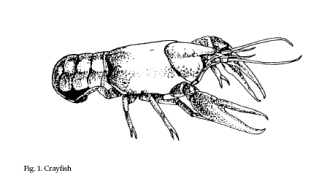|
|
|
|
 |
REPTILES, AMPHIBIANS, ETC: Crayfish |
|
|

Identification, Range, and Biology
Crayfish, also called
crawfish, crawcrab, crab, stonecrab, crawdad, creekcrab,
and other local names, are native to fresh waters on all
continents except Africa, where they have been widely
introduced. There are over 400 species in the family
Astacidae worldwide, and approximately 300 species in
the United States. In size, shape, and color, the
variation is extremely wide among species. The detailed
life histories and habits of all species of crayfish are
beyond the scope of this handbook.
Crayfish are economically
important in a number of states for use as fish bait and
for human consumption. In Louisiana, the crayfish is a
major economic crop and comprises the second largest
aquaculture industry in North America. Over 130,000
acres (56,000 ha) are devoted solely to crayfish
culture.
Damage
Most damage associated
with crayfish is the result of crayfish burrowing in
home lawns. Burrows created by burrowing species of
crayfish are damaging to turf areas and may be hazardous
to mowing machinery. Newly planted rice fields may be
damaged by foraging crayfish where local populations are
high.
Crayfish populations in
commercial baitfish ponds can reduce reproduction by
feeding on the eggs of the baitfish as they are
deposited on spawning mats. During pond harvest,
crayfish caught in the nets injure and destroy baitfish
as they are being harvested for market.
Unwanted populations of
crayfish have been established in the wild because of
the release of bait crayfish. Some populations have
reached extremely high levels. Crayfish can reduce game
fish populations by preying on eggs and fry. They also
can degrade habitat by destroying aquatic vegetation.
Legal Status
Crayfish may be protected
by law in some states. Harvest of crayfish may also be
regulated by state wildlife conservation agencies. In
areas where damage occurs, control measures are
generally unrestricted. Check with your local
agricultural or wildlife authorities before initiating
control. Unwanted populations of crayfish have resulted
in regulations against the use of crayfish as bait in
some northern lakes.
Damage
Prevention and Control Methods
Cultural Methods
Deep cultivation helps
reduce burrowing crayfish populations in rice fields and
other grain crops. Drainage of rice irrigation canals
and fallow fields during fall and winter is also helpful
in reducing crayfish populations in these areas.
High populations of
crayfish are generally associated with years of high
rainfall. Unseasonably dry weather conditions usually
reduce crayfish numbers.
Rapid drainage of baitfish
ponds during early spring helps eliminate crayfish by
exposing them to predators before burrowing activities
begin. Principal predators include snakes, raccoons,
mink, otter, skunks, bass, catfish, ibis, and herons.
Toxicants
There are no General Use
Pesticides registered for crayfish control. In some
states, however, Special Local Needs registration under
section 24(c) of FIFRA have been established for certain
insecticides for burrow treatment.
Toxicants, where legal,
may be used at any time of the year when crayfish are
active, but best results are obtained in early fall when
adults are in their burrows. To be effective,
applications of toxic chemicals must reach the water in
the burrows. Additional treatments may be necessary
where burrows in dikes or dams open at the bottom into a
pond or stream.
Fumigants
None are federally
registered for crayfish control. Check with your local
wildlife or agricultural agency for Special Local Needs
registrations.
Trapping
Wire cage traps, baited
with fish, chicken, or other meat can be used to capture
crayfish, but they are not cost-effective in damage
control situations.
Acknowledgments
Figure 1 by Emily Oseas
Routman.
For Additional Information
Hobbs, H. H., Jr. 1972. Crayfishes (Astacidae) of North
and middle America. Identification Manual No. 9, Biota
of Freshwater Ecosystems, US Environ. Prot. Agency.
Washington, DC. 173 pp.
Momot,
W. T., G. Howing, and P. D. Jones. 1978. The dynamics of
crayfish and their role in ecosystems. Am. Midl. Nat.
99:10-35.
Pennak,
R. W. 1978. Freshwater invertebrates of the United
States, 2d ed. John Wiley and Sons, New York. 803 pp.
Pflieger,
W. L. 1987. An introduction to the crayfish of Missouri.
Missouri Dep. Conserv. Jefferson City. 16 pp.
Williams, A. B., and A. B.
Leonard. 1952. The crayfishes of Kansas. Univ. Kansas,
Sci. Bull. 34:961-1012.
Editors
Scott E. Hygnstrom Robert
M. Timm Gary E. Larson
PREVENTION AND CONTROL OF
WILDLIFE DAMAGE — 1994
Cooperative Extension
Division Institute of Agriculture and Natural Resources
University of Nebraska -Lincoln
United States Department
of Agriculture Animal and Plant Health Inspection
Service Animal Damage Control
Great Plains Agricultural
Council Wildlife Committee
01/26/2007
Special
thanks to:
Clemson University
|